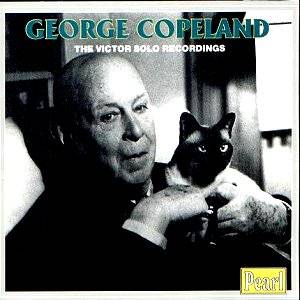Not so long ago I reviewed
another Pearl collection of George Copeland material – GEM
0121 – that contained rare live recordings made during the years
1957-63. Copeland (1882-1971) had long been active as a Debussy
propagandist in his native America, performing premieres and all-Debussy
programmes from the early years of the century. He first met the
composer in 1911 and was famous for having performed at least
one piece by the composer in all his recitals, from 1905 to his
last in 1964. Copeland was a specialist; French and Spanish works
were his great strengths. Concertos were almost totally absent
from his repertoire and he publicly performed precious little
of the central classics. The solo Victors, dating from 1933 to
1938, and presented here are, in fact, a perfectly precise reflection
of his recitals and are naturally dominated by the composer who
once, so famously, said of him "Mr Copeland, I never thought
to hear my music played as well as that in my lifetime."
His colouristic virtues in Debussy have often
been noted, as has the frequently astonishing rhythmic élan
of his playing. His delineation of complex textual strands in
this repertoire is especially notable and we have in these solo
discs precious examples of contemporary performance practice from
a known and admired exponent. His own transcription of Prelude
à L’après-midi d’un Faune is characteristic
inasmuch as it features playing of translucent tonal qualities
supported by a rhythmic acuity that is at once profound and also
perfectly relaxed. If not all his Debussy strikes one as gloriously
as this it is still a potent reminder of his interpretative powers.
His Clair de lune for example might be considered
by some to be unmannered and dulcet; others might find it plain
and frankly just a little dull. His much later live performance
however – to be found on the Pearl set noted above – was very
much in the same mould and his conception hardly changed through
the intervening quarter of a century; it was the way he felt it.
The Sarabande is most attractive and his playing of a few
of the Preludes that he recorded show how advanced a thinker and
how precise and convincing was his conception. Of course there
will be cavils; La Puerta del Viño from Preludes
Book II never really gets off the ground rhythmically speaking
(unusually for Copeland in view of his usual mastery).
His command over other aspects of the modernist
French repertoire is no less singular. His sole Satie features
excellent diminuendi and also a degree of implacability and the
Milhaud has great refinement of delicacy and touch. As much as
the French played so important a role in his aesthetic sympathies,
Copeland was also an avowed exponent of Spanish music. The roll
call of names, big, small and dictionary-scurrying is vast – Turina,
Albeniz, Nin, Infante, Mompou, de Falla, all, are here, and so
are Lecuona, Pittaluga, Lehmberg and Zuera amongst others, usually
represented by a single work, often tangy and zesty with dance
rhythms predominant. This was Copeland’s forte and he relishes
the repertoire. Along the way one will succumb to the infectious
brio of his Mompou Cancion y Danza No. 4, the rubato
laden Albeniz, his quick fingers and colouration of the same composer’s
Malagueña as well as the powerful drama of his Turina.
His Longas Torres Aragon drives deliciously whereas Villa-Lobos’s
Saudades des selvas Brasileiras No. 2 is songful and inward.
The last time I reviewed his Bach Chorale Prelude Jesus Christus,
Gottes Sohn in the famous Walter Rummel arrangement
was in a Naxos disc of Bach piano transcriptions. It’s a great
performance that grows in stature the more one hears it (even
if I do prefer Rummel’s own recording) and this Pearl sounds much
better than the Naxos – clearer, less muddied and ringingly triumphant.
The disc also includes five live performances from Copeland’s
last recital in 1964; all are consonant with his earlier playing,
his technique having weathered better than most in the intervening
years. The Suite of Sixteenth Century pieces is a bit distant
and splintery sound-wise but the playing is as magnetic as before,
Copeland having the knack, seldom over-exploited, of rising to
a dramatic apex of a piece in a fluorescence of colour.
The note by Charles Timbrell is concise and helpful
and, as I have intimated, whilst the sound of the late live recitals
is a little clattery, the Victors have been most judiciously transferred.
Admittedly they were in fine, forward sound for their time but
they sound particularly well here. Of the two Copelands in the
Pearl catalogue this is the one to which I’d direct you and by
which you would profit more.
Jonathan Woolf



